Welcome to our in-depth exploration of sustainable coffee farming. In this article, we will delve into the practices, techniques, and initiatives that contribute to the production of socially and environmentally responsible coffee. As the demand for sustainable agriculture continues to grow, it has become imperative for the coffee industry to embrace eco-friendly practices and ensure the long-term viability of coffee farming.
Key Takeaways:
- Sustainable coffee farming focuses on socially and environmentally responsible practices in coffee production.
- Regenerative agriculture, organic farming, and fair trade are key components of sustainable coffee farming.
- Optimizing soil health and nitrogen levels is crucial for coffee quality and productivity.
- The coffee industry is constantly evolving, with innovations in farming techniques and processing technologies.
- The future of coffee farming depends on research, innovation, and collaboration to address challenges such as climate change and competition.
The Origin of Coffee and Its Evolution in Farming Practices
Coffee, a beloved beverage enjoyed by millions around the world, has a rich history that traces back to its origins in Ethiopia. From there, it spread to the Arabian Peninsula and eventually made its way to different corners of the globe. As the popularity of coffee grew, so did the need for innovative farming practices to meet the demand for this beloved brew.
Over time, coffee farming practices have evolved to ensure sustainability and promote environmentally friendly cultivation techniques. One such practice is shade-grown coffee, which involves growing coffee plants under the shade of taller trees. This approach provides various benefits, such as improved soil health, reduced water usage, and the preservation of biodiversity.
Shade-Grown Coffee: A Sustainable Approach
Shade-grown coffee not only benefits the environment but also enhances the flavor profile of the coffee beans. The slower maturation process that occurs in the shade leads to a denser bean and a more complex flavor. It also allows for the natural development of sugars, resulting in a sweeter cup of coffee.
Coffee farmers are constantly exploring new farming techniques and innovations to increase productivity while minimizing the environmental impact. These innovations range from precision farming techniques that optimize resource utilization to the use of advanced technologies in coffee processing and harvesting.
By embracing sustainable coffee farming practices and continuously evolving their cultivation techniques, coffee farmers are not only ensuring the longevity of their farms but also contributing to the conservation of the environment for future generations.
| Benefits of Shade-Grown Coffee | Environmental Impact | Flavor Profile |
|---|---|---|
| Improved soil health | Preserves biodiversity | Complex and nuanced flavors |
| Reduced water usage | Enhances habitat for birds and other wildlife | Sweet and balanced taste |
| Conserves natural resources | Reduces deforestation | Smoother finish |
As the world of coffee farming continues to evolve, innovative practices and sustainable approaches are key to ensuring a future where coffee production is both environmentally responsible and economically viable.
Exploring the Complexities of Coffee Cultivation
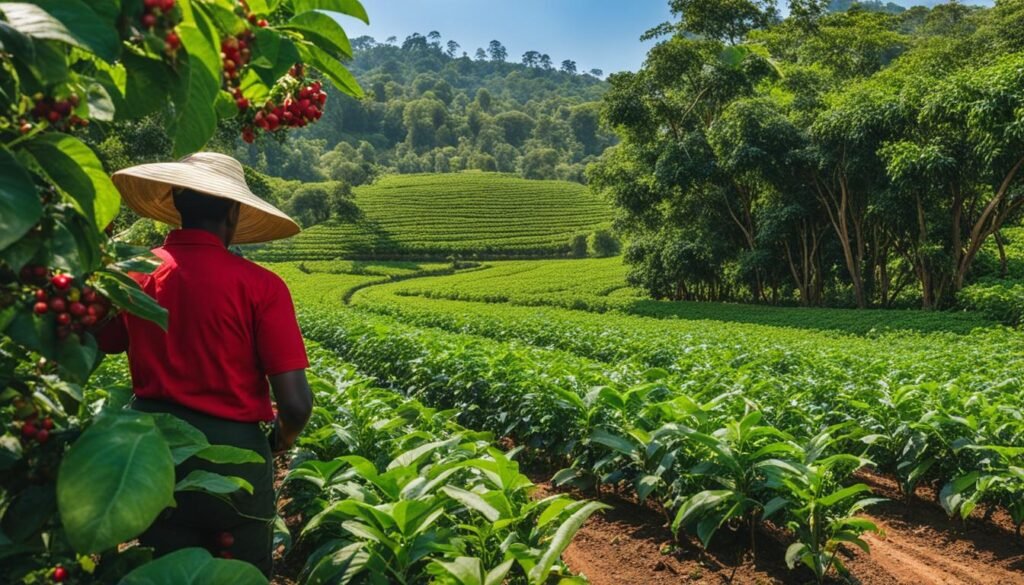
Coffee cultivation involves a complex process that requires careful attention to various factors. From selecting the right location and soil to managing pests and diseases, farmers must consider every aspect of coffee cultivation. Sustainable coffee farming practices aim to minimize the impact on the environment and promote organic farming methods. The sustainability of coffee cultivation also depends on using renewable energy sources, reducing water usage, and implementing waste management solutions.
When it comes to coffee cultivation techniques, farmers employ various methods to ensure healthy and thriving coffee plants. These techniques include proper pruning to shape the coffee tree and improve air circulation, which reduces the risk of diseases. Additionally, coffee farmers use organic fertilizers and compost to enrich the soil and provide essential nutrients to the coffee plants.
In sustainable coffee farming, pest and disease management is crucial to maintain the health of coffee crops. Farmers implement integrated pest management strategies, combining cultural, biological, and chemical control methods to minimize the use of synthetic pesticides. This approach helps preserve the natural balance of the ecosystem and promotes the sustainability of coffee cultivation.
Common Coffee Pests and Diseases
| Pests | Diseases |
|---|---|
| Coffee berry borer | Coffee leaf rust |
| Antestia bug | Coffee wilt disease |
| Green scale | Coffee berry disease |
By adopting sustainable coffee farming practices and implementing effective pest and disease management techniques, coffee farmers can ensure the long-term sustainability of their crops and contribute to the preservation of the environment.
Through sustainable coffee farming, we can cultivate coffee in harmony with nature, protecting the health of the ecosystem and the livelihoods of coffee farming communities. By employing organic farming methods, reducing our environmental footprint, and prioritizing the well-being of both people and the planet, we can create a sustainable coffee industry that continues to thrive for generations to come.
Sustainable Coffee Farming: Balancing Productivity and Environmental Conservation

At [company name], we believe that sustainable coffee farming is the key to achieving a harmonious balance between productivity and environmental conservation. By embracing organic farming practices, implementing renewable energy solutions, and considering the social and economic impacts of our actions, we can ensure a thriving coffee industry that benefits both the planet and the communities involved.
Organic farming practices play a crucial role in sustainable coffee farming. By reducing the use of synthetic fertilizers and pesticides, farmers can protect the soil, water, and surrounding ecosystems from harmful chemicals. This not only benefits the environment but also contributes to the production of healthier and more flavorful coffee beans. Organic farming promotes biodiversity, enhances soil health, and minimizes the risk of water contamination, creating a sustainable and ecologically balanced farming system.
In addition to organic farming, renewable energy sources are being increasingly integrated into coffee farming operations. By harnessing the power of solar, wind, or hydro energy, farmers can reduce their dependency on fossil fuels and significantly lower their carbon footprint. Renewable energy solutions not only contribute to a cleaner environment but also help to minimize operational costs, making coffee farming more economically sustainable in the long run.
The social and economic impacts of sustainable coffee farming are equally important. By ensuring fair prices for coffee farmers and providing support for their communities, we can create a more equitable and inclusive coffee industry. Initiatives such as fair trade and direct trade promote better livelihoods for farmers, empower local communities, and foster long-term partnerships based on transparency and mutual respect. By investing in these social and economic aspects, we can strengthen the entire coffee supply chain and contribute to the social sustainability of the industry.
Table: A Comparison of Sustainable Coffee Farming Practices
| Sustainable Coffee Farming Practice | Benefits |
|---|---|
| Organic farming | Biodiversity conservation, soil and water protection, healthier coffee beans |
| Renewable energy use | Reduced carbon footprint, lower operational costs |
| Fair trade and direct trade | Equitable prices, better livelihoods for farmers, community empowerment |
By embracing sustainable coffee farming practices, we can pave the way for a future where coffee production is not only environmentally responsible but also socially and economically beneficial. Through organic farming, renewable energy use, and fair trade initiatives, we can create a positive impact on both the planet and the lives of the hardworking coffee farmers who make our daily cup of coffee possible.
Coffee Harvesting and Processing: Techniques and Innovations
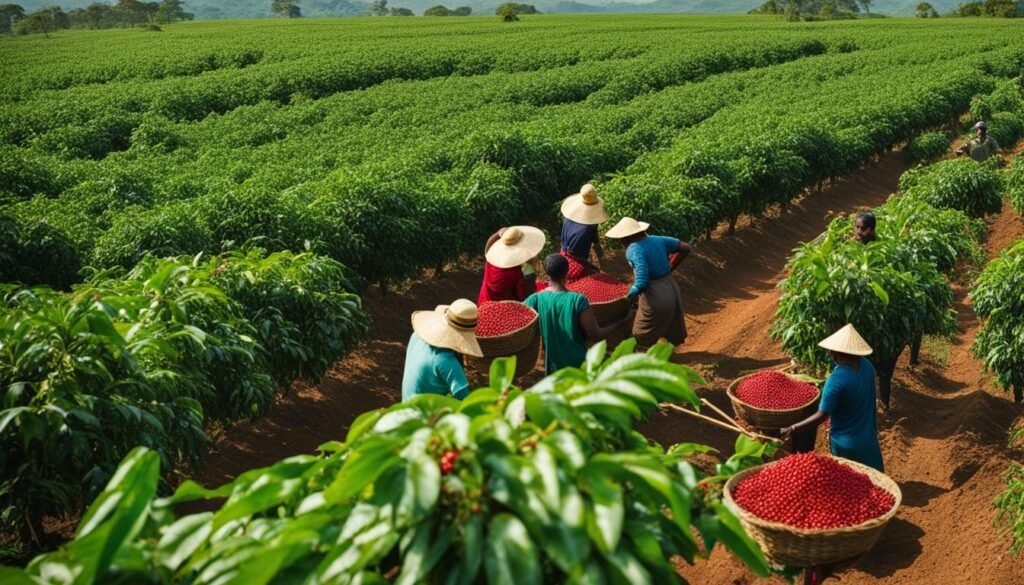
In the coffee industry, the process of harvesting and processing coffee is crucial in determining the quality and flavor of the final product. Coffee harvesting techniques vary depending on the region and the desired level of ripeness. The two main methods for coffee harvesting are manual picking and mechanical harvesting.
Manual picking involves skilled workers selectively harvesting only the ripe coffee cherries by hand. This method allows for greater control and ensures that only the highest quality cherries are harvested. On the other hand, mechanical harvesting involves the use of machines that shake the coffee trees, causing the cherries to fall onto a collection surface. While mechanical harvesting is more efficient, it may result in a mix of ripe and unripe cherries.
Once the coffee cherries have been harvested, they undergo a series of processing methods. The two main coffee processing methods are the dry method and the wet method. The dry method, also known as natural processing, involves drying the cherries in the sun. This allows the cherries to naturally ferment as they dry, imparting a unique flavor profile to the coffee. In contrast, the wet method, also known as washed processing, involves removing the skin and pulp from the cherries before fermenting and washing the beans. This method produces a cleaner and brighter cup of coffee.
In recent years, there have been several innovative coffee processing technologies that have emerged. One such innovation is the use of controlled fermentation. By carefully controlling the fermentation process, coffee producers can enhance the flavor and aroma of the beans. Additionally, advancements in drying technologies have allowed for more efficient and environmentally friendly methods of drying coffee cherries. These innovations contribute to the overall quality and sustainability of the coffee industry.
Coffee Harvesting Techniques
The harvesting of coffee involves specific techniques to ensure the beans are picked at their optimal ripeness. The main harvesting techniques used in the coffee industry are:
- Strip Picking: This technique involves stripping all the cherries from a branch in one go. It is often used in countries with flatter terrains, where mechanical harvesters can easily access the coffee trees.
- Selective Picking: This method involves selectively picking only the ripe cherries by hand. Skilled workers carefully assess the ripeness of each cherry, ensuring that only the highest quality beans are harvested.
- Combining Harvesting: Combining harvesting is a mechanical method that is more commonly used in larger coffee plantations. It involves using machines that shake the coffee trees, causing the cherries to fall onto a collection surface.
Coffee Processing Methods
After the coffee cherries have been harvested, they undergo various processing methods to remove the outer layers and reveal the coffee beans. The two main coffee processing methods are:
- Dry Method (Natural Processing): In this method, the whole coffee cherries are spread out to dry in the sun. The cherries are raked and turned regularly to ensure even drying. Once the cherries are fully dried, the outer layers are removed to reveal the coffee beans.
- Wet Method (Washed Processing): In this method, the cherries are pulped to remove the outer skin and pulp. The beans are then soaked in water tanks, where fermentation occurs, loosening the remaining layers. Finally, the beans are washed and dried.
Innovative Coffee Processing Technologies
Advancements in technology have led to the development of innovative coffee processing techniques, enhancing the quality and efficiency of coffee production. Some of these innovations include:
- Controlled Fermentation: This technique involves carefully controlling the fermentation process to achieve specific flavor profiles. By manipulating the duration and conditions of fermentation, coffee producers can enhance the flavor and aroma of the beans.
- Improved Drying Technologies: Innovations in drying technologies have allowed for more efficient and sustainable methods of drying coffee cherries. These technologies help reduce water usage and energy consumption while maintaining the quality of the beans.
- Alternative Processing Methods: In addition to the traditional dry and wet methods, there are alternative processing methods that have gained popularity. These methods include honey processing, where the skin is partially removed, and anaerobic fermentation, where the cherries are fermented in a low-oxygen environment.
| Method | Description |
|---|---|
| Dry Method (Natural Processing) | In this method, the whole coffee cherries are spread out to dry in the sun. The cherries are raked and turned regularly to ensure even drying. Once the cherries are fully dried, the outer layers are removed to reveal the coffee beans. |
| Wet Method (Washed Processing) | In this method, the cherries are pulped to remove the outer skin and pulp. The beans are then soaked in water tanks, where fermentation occurs, loosening the remaining layers. Finally, the beans are washed and dried. |
| Controlled Fermentation | This technique involves carefully controlling the fermentation process to achieve specific flavor profiles. By manipulating the duration and conditions of fermentation, coffee producers can enhance the flavor and aroma of the beans. |
| Improved Drying Technologies | Innovations in drying technologies have allowed for more efficient and sustainable methods of drying coffee cherries. These technologies help reduce water usage and energy consumption while maintaining the quality of the beans. |
By using these coffee harvesting techniques, processing methods, and innovative technologies, the coffee industry can continue to meet the increasing demand for high-quality coffee while ensuring sustainability and efficiency. These advancements contribute to the unique flavors and characteristics that coffee lovers around the world enjoy.
From Farm to Cup: Understanding the Coffee Supply Chain

The coffee supply chain is a complex network that connects coffee farmers, roasters, and retailers, ultimately bringing the beloved beverage to our cups. Understanding this supply chain is crucial for appreciating the journey that coffee takes from the farm to our morning rituals.
At the heart of the coffee supply chain are the coffee farmers, who cultivate and harvest the coffee beans. These farmers dedicate their time and expertise to ensuring the quality and sustainability of the coffee they produce. They face challenges such as fluctuating market prices, climate change, and the need for fair compensation for their labor.
Once the coffee beans are harvested, they are processed and transported to roasters. Coffee roasters play a vital role in bringing out the flavors and aromas that we associate with our favorite brews. They carefully roast the beans to different profiles, allowing us to experience a vast range of flavors and intensities.
Finally, the roasted coffee beans are packaged and distributed to coffee shops, supermarkets, and other retailers where they are enjoyed by coffee lovers around the world. This final step in the supply chain ensures that coffee is readily available and accessible to consumers who crave their daily cup.
The Importance of Fair Trade and Direct Trade Coffee
Within the coffee supply chain, there is a growing movement towards fair trade and direct trade coffee. Fair trade enables farmers to receive fair prices for their crops, ensuring their livelihoods and enabling them to invest in sustainable farming practices. Direct trade goes a step further, establishing direct relationships between farmers and roasters, fostering transparency, and allowing for more equitable partnerships.
Building Sustainable and Ethical Coffee Supply Chains
Building sustainable and ethical coffee supply chains requires collaboration and commitment from all parties involved. Coffee companies, consumers, and industry organizations have a responsibility to support and promote practices that protect the environment, ensure fair compensation for farmers, and foster long-term sustainability.
| Benefits of Fair Trade Coffee | Benefits of Direct Trade Coffee |
|---|---|
|
|
By supporting fair trade and direct trade coffee, we can contribute to a more sustainable and equitable coffee supply chain. Every cup of coffee we enjoy is an opportunity to make a positive impact on the lives of coffee farmers and the environment.
The Future of Coffee Farming: Challenges and Opportunities
In the face of climate change, coffee farming is confronting significant challenges. Rising temperatures, unpredictable weather patterns, and increased pest and disease pressure pose a threat to coffee-growing regions worldwide. These factors have a direct impact on the quality and quantity of coffee crops, jeopardizing the livelihoods of farmers and the future supply of this beloved beverage.
Furthermore, coffee farmers face competition for land and resources from other crops and land uses. As global demand for agricultural products continues to rise, coffee farming must find ways to compete in an ever-changing landscape.
However, amidst these challenges lie opportunities for the future of coffee farming. Sustainable farming practices can help mitigate the effects of climate change and ensure the long-term viability of coffee cultivation. By implementing regenerative agriculture techniques, such as agroforestry and soil health management, farmers can promote environmental conservation while maintaining productivity. These practices not only contribute to climate change mitigation but also enhance soil fertility, biodiversity, and water management on coffee farms.
Research and innovation play a vital role in shaping the future of coffee farming. Ongoing studies and advancements in agricultural technology can help address the challenges faced by farmers. From disease-resistant coffee varieties to precision farming techniques, these innovations enable farmers to adapt to changing conditions, improve crop yields, and minimize resource usage.
Challenges:
- Rising temperatures and unpredictable weather patterns
- Increased pest and disease pressure
- Competition for land and resources
Opportunities:
- Implementation of sustainable farming practices
- Adoption of regenerative agriculture techniques
- Investment in research and innovation
| Challenges | Opportunities |
|---|---|
| Rising temperatures and unpredictable weather patterns | Implementation of sustainable farming practices |
| Increased pest and disease pressure | Adoption of regenerative agriculture techniques |
| Competition for land and resources | Investment in research and innovation |
Regional Differences in Coffee Farming Practices and Flavors

When it comes to coffee farming, different regions around the world have their own unique practices and traditions. These regional differences not only influence the way coffee is grown but also contribute to the distinct flavors and characteristics found in each cup. Let’s take a closer look at some of these regional variations and the traditional coffee preparation methods that make them special.
Coffee Farming Practices
In Latin America, coffee farms are often located in high-altitude regions, where the cooler climate and volcanic soils create ideal conditions for Arabica coffee cultivation. Farmers in this region employ techniques such as shade-grown farming, which involves planting coffee trees under the protective canopy of larger shade trees. This method not only helps preserve the natural habitat but also enhances the flavor profile of the coffee, resulting in bright acidity and fruity notes in the cup.
In contrast, African coffee farming takes place in lowland regions, where the warmer climate and rich, fertile soils contribute to the bold and earthy flavors often associated with African coffees. Many African coffee farmers practice a unique method called “dry processing” or “natural processing,” where the coffee cherries are sun-dried with their pulp intact. This imparts distinct fruity and wine-like flavors to the beans, creating a truly unique coffee experience.
Asian coffee farming, particularly in countries like Indonesia and Vietnam, often involves intercropping coffee with other crops, such as tea or spices. This traditional farming method helps farmers optimize land use and diversify their income while maintaining sustainable agricultural practices. The resulting coffee is often characterized by complex and spicy flavor profiles, reflecting the influence of the neighboring crops.
Traditional Coffee Preparation Methods
In addition to farming practices, traditional coffee preparation methods also contribute to the regional diversity of coffee. For example, in Latin America, particularly in countries like Colombia and Brazil, the “pour-over” method is a popular and traditional way of brewing coffee. This method involves pouring hot water over a filter containing ground coffee, allowing for full control over the extraction process and producing a clean and vibrant cup of coffee.
In African countries, such as Ethiopia and Kenya, the traditional coffee ceremony is an integral part of the culture. This ceremonial preparation involves roasting the coffee beans over an open fire, grinding them by hand, and brewing the coffee in a traditional clay pot known as a jebena. The result is a rich, aromatic coffee with a distinctively bold flavor.
Asian countries have their own unique coffee traditions as well. For example, in Vietnam, a popular method of coffee preparation is the “Vietnamese drip coffee” style. This involves using a small metal filter placed on top of a cup, with ground coffee added to the filter and hot water poured over it. The coffee then slowly drips into the cup, resulting in a strong and flavorful brew.
Overall, the regional differences in coffee farming practices and traditional preparation methods contribute to the diverse flavors and experiences that coffee lovers enjoy around the world. Understanding these variations allows us to appreciate the rich cultural heritage behind each cup of coffee we savor.
Starbucks’ Efforts in Sustainable Coffee Farming
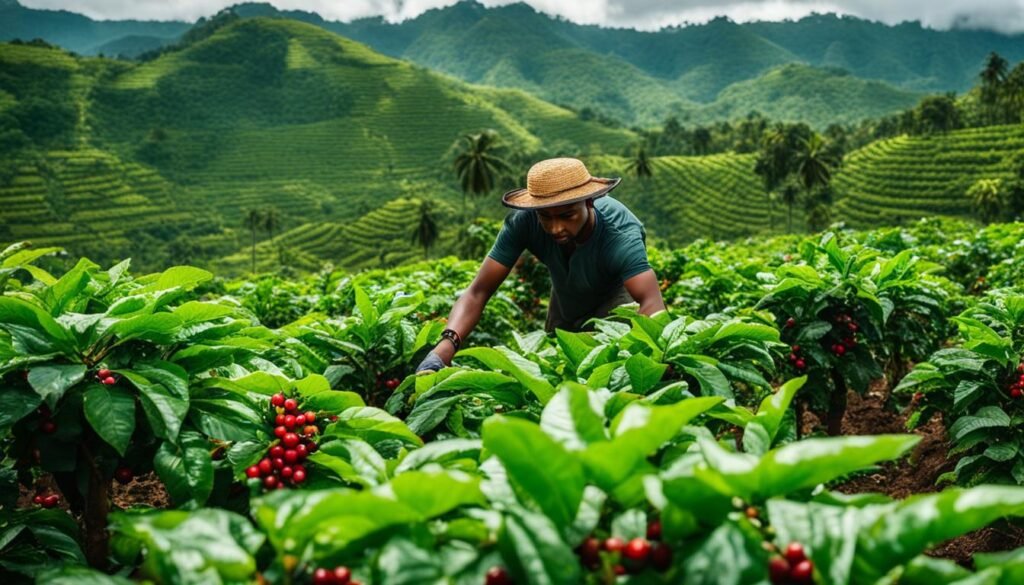
At Starbucks, we are committed to making a positive impact on coffee farming communities and promoting sustainable practices throughout the industry. Through our initiatives, we aim to support coffee growers, protect the environment, and ensure the long-term sustainability of the coffee supply chain.
One of our key initiatives is the establishment of Farmer Support Centers. These centers provide resources, training, and support to coffee farmers, helping them improve their farming practices and increase their yields. By sharing our knowledge and expertise, we empower farmers to adopt sustainable techniques, enhance their livelihoods, and grow high-quality coffee.
In addition to training and support, we also focus on addressing the challenges faced by coffee farmers. Through our partnership with organizations like Conservation International, we donate disease-resistant trees to help farmers combat threats like coffee leaf rust. This not only protects the livelihoods of farmers but also ensures the long-term viability of coffee production.
| Initiative | Description | |
|---|---|---|
| 1 | Farmer Support Centers | Provide resources, training, and support to coffee farmers. |
| 2 | Disease-Resistant Trees | Donate trees to help farmers combat threats like coffee leaf rust. |
| 3 | Global Farmer Fund | Invest in financing for farmers, ensuring access to capital and resources. |
Furthermore, we have established the Global Farmer Fund, which provides financing to coffee farmers. This fund enables farmers to invest in sustainable farming practices, improve their infrastructure, and enhance their productivity. By supporting coffee farming communities with access to capital and resources, we contribute to their long-term success and the sustainability of the coffee industry.
Through these initiatives and partnerships, Starbucks is dedicated to driving positive change in the coffee industry. We believe that by working together, we can create a future where sustainable coffee farming is the norm, benefiting farmers, the environment, and coffee lovers around the world.
Making Coffee the First Sustainable Agricultural Product
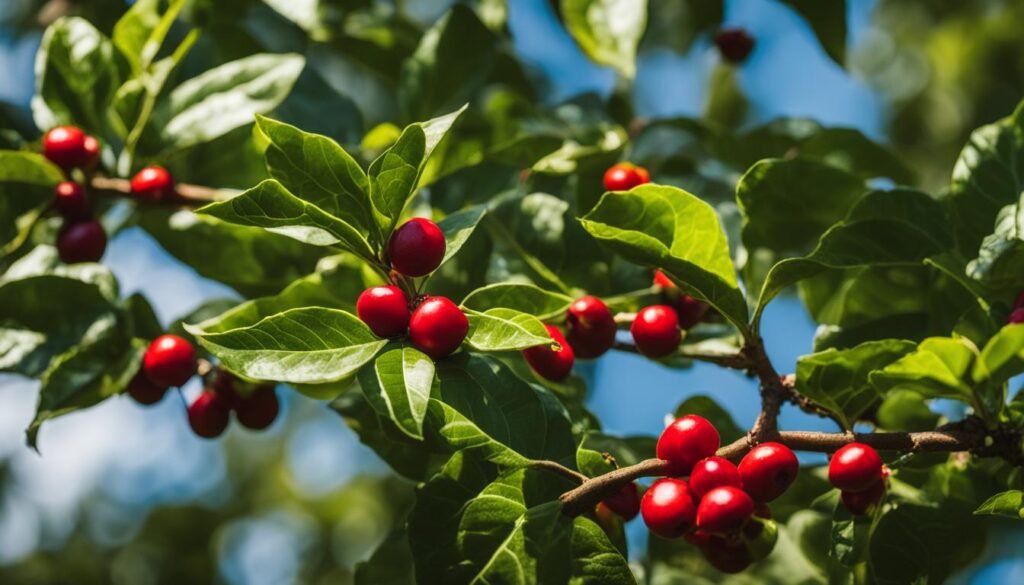
At Starbucks, we are committed to making coffee the world’s first sustainable agricultural product. That’s why we are proud to be a founding member of the Sustainable Coffee Challenge, a coalition of industry leaders working together to ensure the long-term sustainability of the coffee industry.
The Sustainable Coffee Challenge focuses on sustaining the future supply of coffee while ensuring the well-being of farmers, workers, and nature. Through industry collaboration, we aim to achieve 100% sustainable coffee production and create a better future for coffee farming communities.
As part of our commitment, we actively participate in action networks, such as tree replacement initiatives. We believe in the importance of tree planting and re-planting to support the growth of sustainable coffee farming. In line with this, Starbucks has made a commitment to donate disease-resistant trees to help farmers combat threats like coffee leaf rust and other diseases.
By collaborating with the coffee industry and investing in sustainable farming practices, we can create a positive impact on the environment, support the livelihoods of coffee farmers, and ensure a long-term supply of high-quality coffee for generations to come.
| Sustainable Coffee Challenge Initiatives | Impact | |
|---|---|---|
| 1 | Action Network: Tree Replacement | Supports the growth of sustainable coffee farming by donating disease-resistant trees. |
| 2 | Action Network: Climate Resilience | Addresses the impact of climate change on coffee-growing regions and develops strategies for resilience. |
| 3 | Action Network: Conservation in Coffee Landscapes | Promotes biodiversity conservation and sustainable land management practices in coffee-producing areas. |
Why Sustainable Coffee Production Matters
Sustainable coffee production is crucial for several reasons. Firstly, it preserves the environment by promoting eco-friendly farming practices and reducing the use of harmful chemicals. This helps protect the biodiversity of coffee-growing regions and prevents soil degradation.
Secondly, sustainable coffee production supports the livelihoods of coffee farmers and their communities. By ensuring fair prices and working conditions, it improves the economic stability and social well-being of coffee farming communities.
Lastly, sustainable coffee production guarantees the availability of high-quality coffee for consumers. By promoting sustainable farming methods, we can maintain the unique flavors and characteristics of different coffee varieties while ensuring a reliable and consistent supply.
Conclusion
In conclusion, sustainable coffee farming is gaining momentum as brands and consumers recognize the importance of socially and environmentally responsible practices. By implementing regenerative agriculture, organic farming methods, and renewable energy use, coffee farmers can strike a balance between productivity and environmental conservation. Initiatives such as fair trade and direct trade play a crucial role in supporting the well-being of farmers and ensuring equitable prices.
The future of coffee farming depends on research, innovation, and collaboration across the industry. By investing in sustainable practices and supporting coffee farming communities, we can guarantee a long-term supply of high-quality coffee while creating a positive impact on the lives of farmers and the environment.
We believe that by embracing sustainable coffee farming, we contribute to the preservation of coffee as a cherished agricultural product. With the continued commitment of industry leaders like Starbucks and collaborations through initiatives like the Sustainable Coffee Challenge, the path towards a fully sustainable coffee industry becomes clearer. Together, we can make a difference and create a better future for coffee farming.
FAQ
What is sustainable coffee farming?
Sustainable coffee farming refers to the practices and techniques used in coffee cultivation that prioritize social and environmental responsibility. It involves minimizing the impact on the environment, promoting organic farming methods, and ensuring the well-being of workers and local communities.
Why is sustainable agriculture important in coffee farming?
Sustainable agriculture is important in coffee farming because it helps mitigate the impact of climate change, protects biodiversity, and promotes the long-term viability of coffee production. It also ensures the quality of the coffee beans and supports the livelihoods of coffee farmers.
What are some sustainable coffee farming practices?
Sustainable coffee farming practices include regenerative agriculture, organic farming, shade-grown coffee, renewable energy use, fair trade, and direct trade. These practices aim to balance productivity with environmental conservation and promote social and economic sustainability.
How does sustainable coffee farming benefit the environment?
Sustainable coffee farming benefits the environment by reducing the use of pesticides, preserving biodiversity, and promoting soil health. It also helps reduce water usage, minimize carbon emissions, and protect natural resources.
How does sustainable coffee farming benefit coffee farmers?
Sustainable coffee farming benefits coffee farmers by promoting fair prices through initiatives like fair trade and direct trade. It also improves farmer livelihoods, supports community development, and ensures a long-term supply of high-quality coffee.
What are the challenges in sustainable coffee farming?
Some challenges in sustainable coffee farming include climate change, competition from other crops, and the need to adopt new technologies and farming practices. It also requires understanding the specific needs of each coffee farm and implementing sustainable practices in a way that balances conservation and commercial production.
How is coffee harvested and processed?
Coffee can be harvested by hand or machine, depending on the farm and region. The two main methods of coffee processing are the dry method and the wet method. The dry method involves drying the cherries in the sun, while the wet method involves removing the outer skin and pulp before drying the beans.
What is the coffee supply chain?
The coffee supply chain involves multiple steps, from coffee farmers to roasters and retailers. Coffee farmers grow and harvest the coffee beans, which are then processed and transported to roasters. The roasted beans are packaged and distributed to coffee shops and supermarkets.
How does Starbucks support sustainable coffee farming?
Starbucks supports sustainable coffee farming through initiatives like partnering with Conservation International, sharing research and resources through Farmer Support Centers, and investing in financing for farmers through the Global Farmer Fund. They also donate disease-resistant trees to coffee farmers and are actively involved in sustainable coffee production initiatives.
What is the Sustainable Coffee Challenge?
The Sustainable Coffee Challenge is a coalition of industry leaders, including Starbucks, working towards making coffee the world’s first sustainable agricultural product. It focuses on sustaining the future supply of coffee while ensuring the well-being of farmers, workers, and nature.
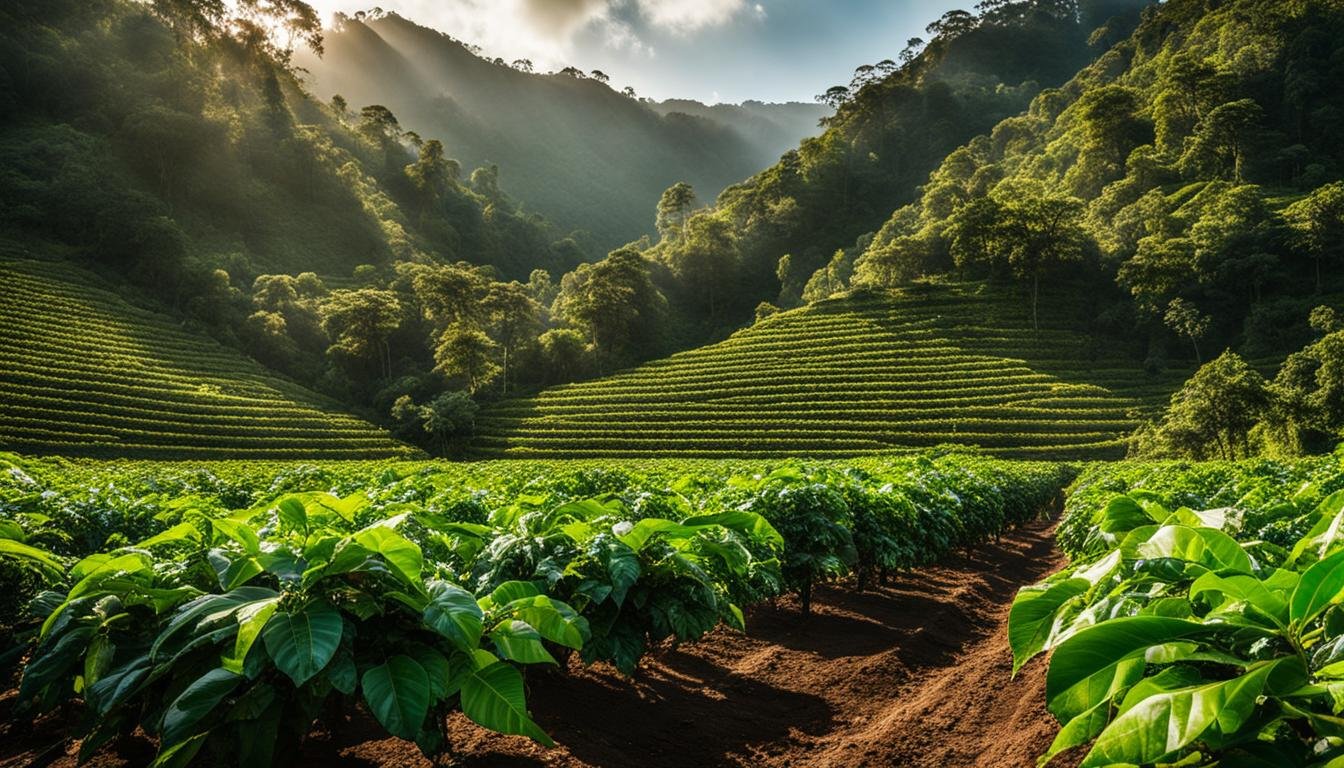
Leave a Reply